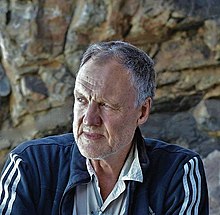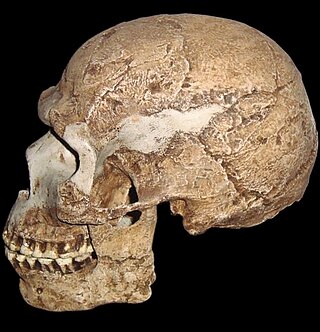
Early modern human (EMH), or anatomically modern human (AMH), are terms used to distinguish Homo sapiens that are anatomically consistent with the range of phenotypes seen in contemporary humans, from extinct archaic human species. This distinction is useful especially for times and regions where anatomically modern and archaic humans co-existed, for example, in Paleolithic Europe. Among the oldest known remains of Homo sapiens are those found at the Omo-Kibish I archaeological site in south-western Ethiopia, dating to about 233,000 to 196,000 years ago, the Florisbad site in South Africa, dating to about 259,000 years ago, and the Jebel Irhoud site in Morocco, dated about 315,000 years ago.

Behavioral modernity is a suite of behavioral and cognitive traits believed to distinguish current Homo sapiens from other anatomically modern humans, hominins, and primates. Most scholars agree that modern human behavior can be characterized by abstract thinking, planning depth, symbolic behavior, music and dance, exploitation of large game, and blade technology, among others.

Africa has the longest record of human habitation in the world. The first hominins emerged 6–7 million years ago, and among the earliest anatomically modern human skulls found so far were discovered at Omo Kibish,Jebel Irhoud, and Florisbad.
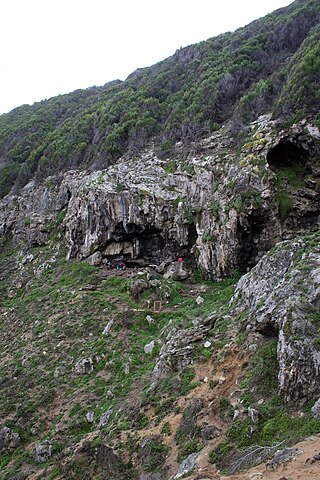
Blombos Cave is an archaeological site located in Blombos Private Nature Reserve, about 300 km east of Cape Town on the Southern Cape coastline, South Africa. The cave contains Middle Stone Age (MSA) deposits currently dated at between c. 100,000 and 70,000 years Before Present (BP), and a Late Stone Age sequence dated at between 2000 and 300 years BP. The cave site was first excavated in 1991 and field work has been conducted there on a regular basis since 1997, and is ongoing.

In archaeology, a bone tool is a tool created from bone. A bone tool can conceivably be created from almost any bone, and in a variety of methods.
The Stillbay or Still Bay industry was named by archaeologists A. J. H. Goodwin and C. van Riet Lowe in 1929, and is a Middle Stone Age stone tool manufacturing style after the site of Stilbaai in South Africa where it was first described. It may have developed from the earlier Acheulian types. In addition to Acheulian stone tools, bone and antler picks were also used.
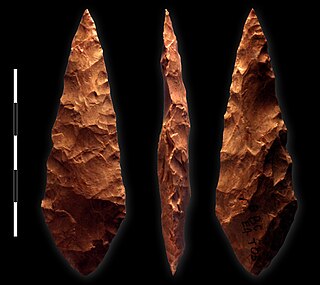
The Middle Stone Age was a period of African prehistory between the Early Stone Age and the Late Stone Age. It is generally considered to have begun around 280,000 years ago and ended around 50–25,000 years ago. The beginnings of particular MSA stone tools have their origins as far back as 550–500,000 years ago and as such some researchers consider this to be the beginnings of the MSA. The MSA is often mistakenly understood to be synonymous with the Middle Paleolithic of Europe, especially due to their roughly contemporaneous time span; however, the Middle Paleolithic of Europe represents an entirely different hominin population, Homo neanderthalensis, than the MSA of Africa, which did not have Neanderthal populations. Additionally, current archaeological research in Africa has yielded much evidence to suggest that modern human behavior and cognition was beginning to develop much earlier in Africa during the MSA than it was in Europe during the Middle Paleolithic. The MSA is associated with both anatomically modern humans as well as archaic Homo sapiens, sometimes referred to as Homo helmei. Early physical evidence comes from the Gademotta Formation in Ethiopia, the Kapthurin Formation in Kenya and Kathu Pan in South Africa.
The Klasies River Caves are a series of caves located east of the Klasies River Mouth on the Tsitsikamma coast in the Humansdorp district of Eastern Cape Province, South Africa. The Klasies River Main (KRM) site consists of 3 main caves and 2 shelters located within a cliff on the southern coast of the Eastern Cape. The site provides evidence for developments in stone tool technology, evolution of modern human anatomy and behavior, and changes in paleoecology and climate in Southern Africa based on evidence from plant remains.

The Prehistory of South Africa lasts from the Middle Stone Age until the 17th century. Southern Africa was first reached by Homo sapiens before 130,000 years ago, possibly before 260,000 years ago. The region remained in the Late Stone Age until the first traces of pastoralism were introduced about 2,000 years ago. The Bantu migration reached the area now South Africa around the first decade of the 3rd century, over 1800 years ago. Early Bantu kingdoms were established in the 11th century. First European contact dates to 1488, but European colonization began in the 17th century.
The prehistory of Africa spans from the earliest human presence in Africa until the ancient period in the history of Africa.
Earliest findings for Hominid art refers to archaeological findings that might be evidence of an artistic awareness and artistic-like activities from early ancestors of modern Homo sapiens. There is no known evidence to indicate artistic activity in hominids of the Middle Stone Age. Artistic activity is defined as decorative production and production of either images or objects such as statues.
Pinnacle Point a small promontory immediately south of Mossel Bay, a town on the southern coast of South Africa. Excavations since the year 2000 of a series of caves at Pinnacle Point, first recognized and documented in 1997 by South African professional archaeologists, Jonathan Kaplan and Peter Nilssen, have revealed occupation by Middle Stone Age people between 170,000 and 40,000 years ago. The focus of excavations has been at Cave 13B (PP13B), where the earliest evidence for the systematic exploitation of marine resources (shellfish) and symbolic behaviour has been documented, and at Pinnacle Point Cave 5–6 (PP5–6), where the oldest evidence for the heat treatment of rock to make stone tools has been documented. The only human remains have been recovered from younger deposits at PP13B which are c. 100,000 years old.
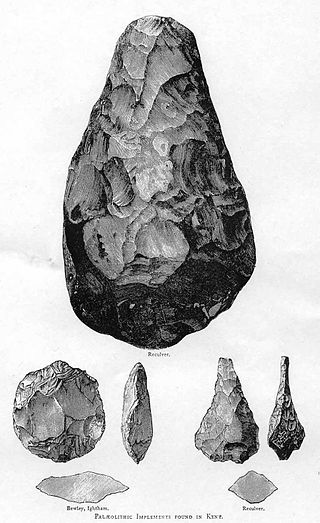
The oldest undisputed examples of figurative art are known from Europe and from Sulawesi, Indonesia, and are dated as far back as around 50,000 years ago . Together with religion and other cultural universals of contemporary human societies, the emergence of figurative art is a necessary attribute of full behavioral modernity.

Sibudu Cave is a rock shelter in a sandstone cliff in northern KwaZulu-Natal, South Africa. It is an important Middle Stone Age site occupied, with some gaps, from 77000 years ago to 38000 years ago.
Howiesons Poort is a technological and cultural period characterized by material evidence with shared design features found in South Africa, Lesotho, and Namibia. It was named after the Howieson's Poort Shelter archaeological site near Grahamstown in South Africa, where the first assemblage of these tools was discovered. Howiesons Poort is believed, based on chronological comparisons between many sites, to have started around 64.8 thousand years ago and ended around 59.5 thousand years ago. It is considered to be a technocomplex, or a cultural period in archaeology classified by distinct and specific technological materials. Howiesons Poort is notable for its relatively complex tools, technological innovations, and cultural objects evidencing symbolic expression. One site in particular, Sibudu Cave, provides one of the key reference sequences for Howiesons Poort. Howiesons Poort assemblages are primarily found at sites south of the Limpopo River.

Border Cave is an archaeological site located in the western Lebombo Mountains in Kwazulu-Natal. The rock shelter has one of the longest archaeological records in southern Africa, which spans from the Middle Stone Age to the Iron Age.
Judith Sealy is a Professor and South Africa Research Chairs Initiative Research Chair in Archaeology and Paleoenvironmental Studies and director of the Stable Light Isotope Lab in the Department of Archaeology at the University of Cape Town.

Lucinda Backwell is an archaeologist and a member of the Academy of Science of South Africa. She obtained her MSc in palaeoanthropology from the University of the Witwatersrand Medical School in 2000. Her PhD in palaeoanthropology was awarded in 2004, making her the first South African woman to be awarded a PhD in palaeoanthropology at a local institution.

Francesco d'Errico is an archaeologist who works as CNRS Director of Research at the University of Bordeaux in France and Professor at the Centre for Early Sapiens Behaviour, University of Bergen. In 2014 he was awarded the CNRS silver medal. In 2015 Giorgio Napolitano, president of Italy, presented him with the Fabio-Frassetto prize from the Accademia dei Lincei.

The prehistory of Southern Africa spans from the earliest human presence in the region until the emergence of the Iron Age in Southern Africa. In 1,000,000 BP, hominins controlled fire at Wonderwerk Cave, South Africa. Ancestors of the Khoisan may have expanded from East Africa or Central Africa into Southern Africa before 150,000 BP, possibly as early as before 260,000 BP. Prehistoric West Africans may have diverged into distinct ancestral groups of modern West Africans and Bantu-speaking peoples in Cameroon, and, subsequently, around 5000 BP, the Bantu-speaking peoples migrated into other parts of Sub-Saharan Africa.
